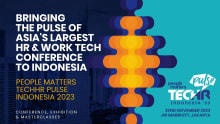Supercharging the HR function through data-driven insights

Over the years, the Human Resource (HR) function has considerably evolved across organisations. – especially with the deployment of human resource management systems (HRMS). As a result, an HR’s role has become technology and data driven. The use of advanced technologies, such as Artificial Intelligence (AI) and Machine Learning (ML), has fostered a significant change in HR processes and practices including the way workforce data is collected, stored, and analysed. This transformation has enabled HR leaders to have 24X7 access to critical HR insights and make decisions without any bias or assumptions. They can foresee trends across the workplace and take informed decisions in time.
Now, more than ever, HR is dependent on data to understand employee sentiments and needs, manage people better and track as well as monitor employee activities. People analytics, in fact, is an emerging discipline that increases efficiency and optimises performance while making smarter workforce decisions.
This is corroborated by the LinkedIn Global Talent Trends 2020 report, according to which 92% of talent professionals in India feel people analytics is paving the way for the future of HR.
Let’s take a closer look at how people analytics is transforming people practices across India.
360-degree insights for organisational growth
Analytic platforms collate data from different data sources - ERPs, excel sheets, social media, HR portals etc., analyse and create a single source of truth for the organisation. As a result, HR leaders are making better decisions with a real-time 360-degree view of the complete business, covering everything from revenue, employee headcount, hiring demand to E-SAT and attrition. For instance, they are able to analyse different data patterns and get predictive insights on hiring demand and attrition in the next 6 to 12 months. HR leaders are leveraging these signals to strategically plan hiring and optimize hiring costs.
Optimising HR budgets
Budget is one of the key elements for operational success. AI and ML-powered analytics platforms provide insights into various expenses associated with each employee, department or business units across multiple locations. For instance, while determining the employee’s pay scale, analytics platforms are helping internal recruiters and hiring managers to recommend a pay plan for vacant positions based on variables such as the candidate’s education, experience, certifications, market demand for the skillset and availability of talent in the region. It helps them determine a compensation plan that is fair to the employee and advantageous to the organisation, thus avoiding any pay gaps.
HR budget comprises many elements such as salary expense, recruitment cost, training and development cost, incentives etc. Too much or too little in any segment directly affects business performance. Therefore, it becomes essential for the management to get timely insights into spending patterns. BI solutions provide a deeper insight into overspending and underspending to understand where leadership can build greater flexibility into the budgets preventing over-hiring, understaffing and high turnover.
Manage attrition and retention
Reducing employee turnover has become a major concern for the HR department. With teams working remotely and reduced human interaction, HR teams need logical, scientific ways to read employee satisfaction. Powered by ML, sentiment analysis helps them in determining areas of concern and leverage insights to curb the attrition rate and enhance retention strategies.
- Spot teams with the highest attrition, take corrective actions.
- Learn best practices from departments where attrition is lowest and replicate that success.
For instance, Xerox applied data-driven analytics to identify what made their customer service employees stay longer. They recognised that employees who have been with the company for the longest are in fact the ones who live in the vicinity of the workplace and have access to reliable transportation. With such findings, they were able to decrease the attrition rate by 20% in a pilot program.
Amid the evolving business scenario due to the COVID-19 pandemic, increasing employee engagement can help in boosting productivity, improving efficiency and reducing attrition. HR leaders can identify existing workplace bottlenecks and find which corporate policies and cultural elements are most important to the employees by using survey analytics.
For instance, Google’s people operation reaped the benefits by tailoring different aspects of its people processes to fit their unique work culture. Their team was able to dig deeper into the company’s inner culture dynamics by mixing quantitative and qualitative data. This resulted in a 90% average participation rate in the surveys!
Streamlining Talent Acquisition
People analytics is also being leveraged to streamline the talent acquisition function. While hiring for positions, analytics solutions can assist in sorting through lists of applicants for various factors, such as education, experience, engagement and growth. This data can also be further analysed to forecast future performance and know the overall fitment of the candidate in an organization. The analytics-driven approach makes the hiring process fast, accurate and bias-free.
Take the case of a leading Indian IT company that scrutinises a database of over 5 million candidates to provide predictive intelligence to talent managers and recruiters to make clear and precise hiring decisions. This enables the HR function to stay informed, hire the right talent at the right time, and run operations efficiently.
Understanding skill requirements
In the last few years, identifying relevant skilling and training opportunities has become one of the key factors in defining an organisation’s success story. Towards this end, the learning and development division can leverage data analytics on parameters, such as learner feedback, employee scores in tests and exams, as well as the time required for completing a course to make informed decisions about employee training requirements.
The HR function of a market-leading IT company in India used natural language processing and semantics analysis to fulfil 17% of training demand through reskilling. Predictive analytics enabled the training personnel to work on appropriate learning modules for employee reskilling and upskilling.
Almost every organisation assesses employee performance annually. This leaves little time for HR to act on possible risks. However, analytics provide real-time performance insights to detect any red flags so that HR can take corrective measures such as implementing tailor-made performance enhancement programs, discussing the matter either with the manager or directly with the employee. E.g. Adani Group uses machine learning-powered analytics to monitor employee behaviour and performance while driving vehicles at Mundra Port. The solution captures metrics such as speeding, taking sharp turns or not following driving norms. This helps HR predict performance of drivers and make timely interventions to optimize performance.
The future outlook
Technologies such as artificial intelligence, machine learning, and data analytics play an integral role in making HR more people centric. From automating everyday processes, getting insights in real-time, empowering HR professionals, increasing productivity to creating inclusive teams, these are just a few data-driven solutions that are supercharging an organisation towards a bright future. As we move forward, harnessing the power of Al and ML-based analytics will only help organisations save cost, optimise employee experience and increase work satisfaction. Intuitive and personalized with an optimum measure of efficiency – these qualities will define analytics-powered HR in the coming years.















